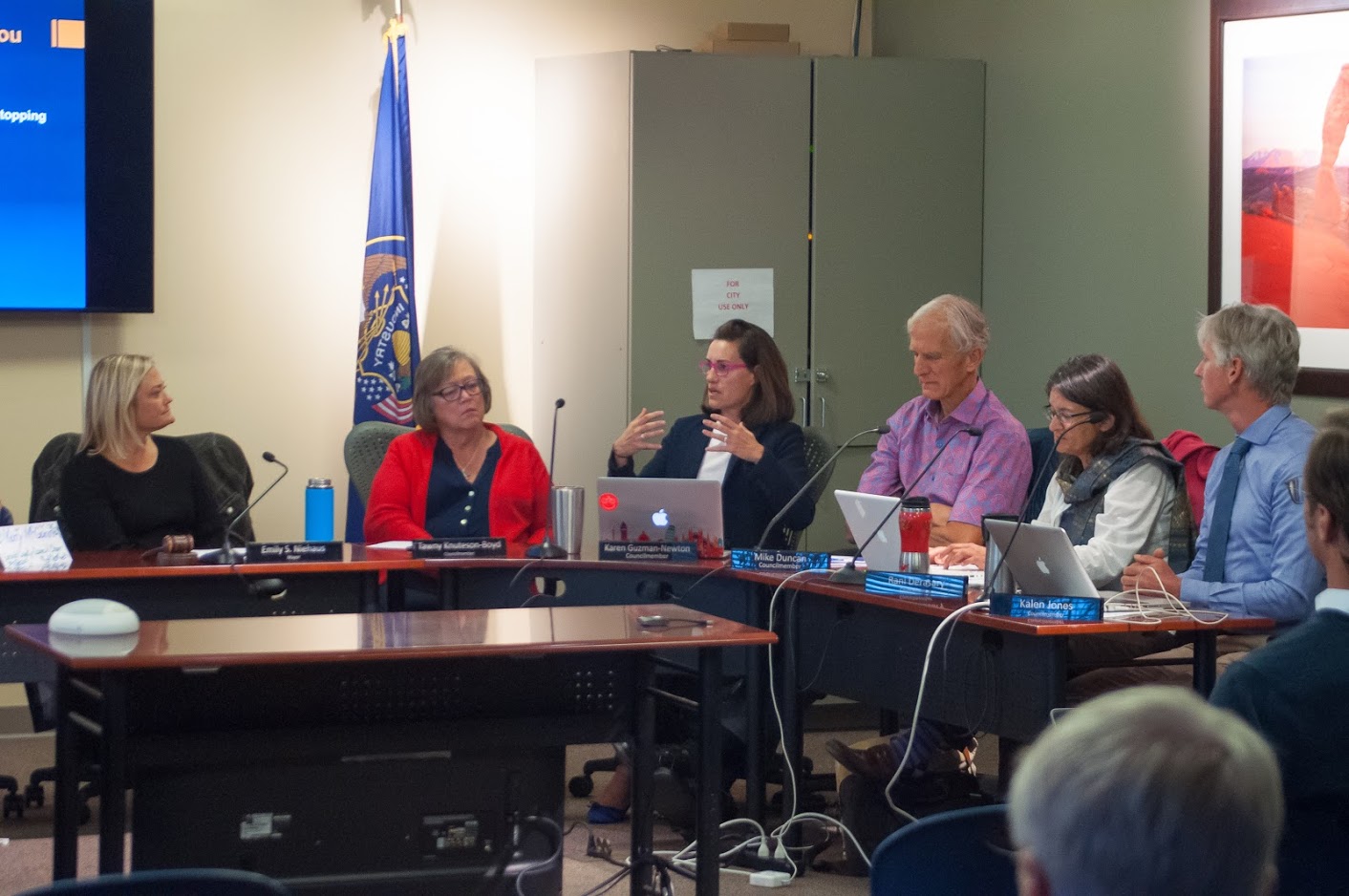Bypass Moab — or not?
Moab and Grand County’s officials contemplated a highway bypass and upcoming legislative priorities during a joint city and county council meeting on Tuesday, Oct. 30.
Lynn Jacobs and Jon Nepstad, representatives from Fehr and Peers Transportation Consultants, have been working for the Utah Department of Transportation (UDOT) on studying and developing possible options for creating a U.S. Highway 191 bypass around Moab.
The biggest reason for creating a bypass is to take traffic off Main Street (the section of U.S. Highway 191 that goes through downtown Moab), which will reduce Main Street traffic noise.
“A truck creates about the same amount of noise as 32 cars,” Jacobs said. A bypass would take the noise level equivalent to 70,000 cars off Main Street, Jacobs said.
A bypass project would cost millions of dollars.
“It’s a pretty heavy cost to bear,” Jacobs said.
For example, Jacobs and Nepstad said that in looking at solutions to mitigate traffic noise, it would cost about $1.3 million to build a 5,000-foot sound wall along a bypass corridor through a residential area near Kane Creek.
Though the officials agreed that the amount of traffic coming into Moab has increased and will continue to increase in years to come, the city and county council members didn’t appear to have a consensus on whether or not to approve of and adopt a bypass in local planning efforts.
Moab City Council member Mike Duncan said when the idea of a bypass has been discussed in past years, there was a concern that it would serve as a deterrent to visitors by taking traffic off Main Street.
The next steps in regards to developing a bypass and eventually securing the funding largely depend on the community’s support, or nonsupport, for a bypass.
“If it’s not supported by the community, it’s not a place we want to pour our resources,” Nepstad said.
Support for the bypass would lead to the creation of an environmental impact study and assessment that takes into account additional comments and concerns about the different kinds of impacts created by a bypass development, Jacobs said.
“We are a major byway for truck traffic,” said city council member Karen Guzman-Newton, “and transportation is a huge thing for the state of Utah, so is it an incentive for the state of Utah to foot the cost of this?”
Grand County Council member Curtis Wells weighed in and said the first step, if the community decides to move forward with a bypass, is to adopt the project in to local transportation plans to “use as leverage” and to show the state transportation commission “that there’s support from the citizens and governing bodies.”
Wells said, “The mayor (Emily Niehaus) and I attended a transportation commission meeting … and we had conversations with some of the transportation commissioners that more or less, the message I received was that they recognized that the state has promoted tourism that’s created congestion. We also heard from UDOT (that the) focus is on freight traffic, so it’s a mutually beneficial situation … if we go for it, we have to make sure that it’s done right … we have to adopt this into our local transportation plans first.”
“If we support it,” Niehaus said, “and I’m curious if it is.”
Niehaus asked the council members to take a “straw poll” to show if they were in favor of the bypass.
“Are we in favor of the bypass?” Niehaus asked, adding that showing support was not a “be all, end all” to support any one particular bypass route plan.
“What about a notion?” city council member Kalen Jones emphasized.
“Yes — a notion of a bypass,” Niehaus clarified. “If you are in favor of the notion of a bypass … I’m curious who is or who is not.”
A handful of council members appeared to give a thumbs-up indicating they favored the notion of a bypass, including county council member Greg Halliday, who said the bypass should have been constructed years ago to accommodate Moab’s growth.
City and county officials also discussed whether plans for future growth should have restrictions.
Moab City Manager David Everitt said, “Visitation has increased dramatically” to the area in recent years.
“We need to plan for future generations,” Niehaus said. “We’re told to plan for double the population, just of ourselves, as population is growing and people are living longer.”
“One of the things I think we can do, both the city and the county,” said county council member Terry Morse, “is to look at the water and if we have between 10,000 and 30,000 acre feet a year coming to our aquifer, that says something about limits of growth and limits of population. I think that we need to make decisions about how much of that is going to be preserved and how much is going to used — and use that for projecting growth and numbers, if you want, down the road … we ought to look into the finite resources and back into where we want to be from that.”
Joint meeting highlights community growth
“Visitation has increased dramatically.”




